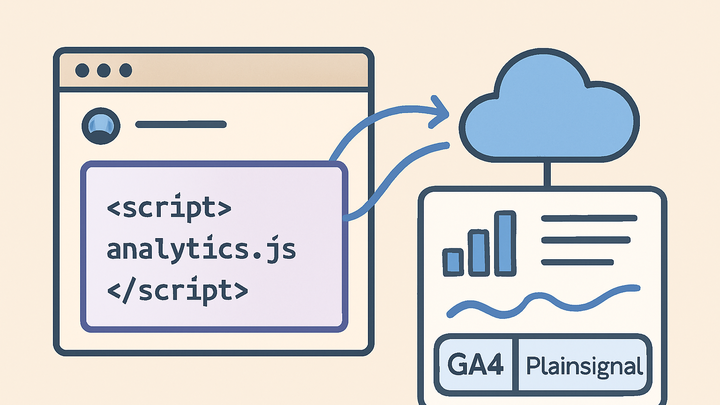Published on 2025-06-22T07:52:09Z
What is a GA Tag? Examples and Uses
GA Tag, short for Google Analytics Tag, is a JavaScript snippet inserted into a website
to capture user interactions such as pageviews, events, and e-commerce transactions. It typically takes
the form of a <script> tag that loads a library like gtag.js (for GA4) or
PlainSignal’s script for cookie-free tracking. When embedded, the tag collects data and sends it to
analytics servers via HTTP requests. GA4 uses a unified data model with Measurement IDs,
whereas alternative platforms like PlainSignal emphasize simplicity, privacy, and no cookies.
Understanding how to configure, place, and customize your GA Tag is essential for accurate and compliant
data collection.
This article covers the anatomy, configuration options, implementation examples, and best practices for both GA4 and PlainSignal tags.
Ga tag
A GA Tag is a JavaScript snippet for collecting website analytics data, central to GA4 and alternatives like PlainSignal.
What is a GA Tag?
A GA Tag is the fundamental building block for web analytics, serving as the mechanism to collect and transmit user interaction data from your website to an analytics platform.
-
Definition
A GA Tag is a JavaScript snippet provided by analytics platforms to track pageviews, events, and user behavior. It loads necessary libraries and initializes tracking configurations.
-
Purpose
The primary purpose of a GA Tag is to capture client-side interactions and send structured data to the analytics backend for aggregation, reporting, and analysis.
Key Components of a GA Tag
This section breaks down the core elements that make up a GA Tag, from the script include to data configurations.
-
Script include
The
<script>tag that loads the analytics library (e.g.,gtag.jsor PlainSignal script) into the webpage. It can include attributes likedefer,async, or custom data attributes. -
Configuration parameters
These parameters include identifiers such as the Google Analytics Measurement ID (
G-XXXXXX) or PlainSignal site ID (data-id). They tell the script which account and property to send data to. -
Data layer and events
Optional JavaScript objects or functions used to push additional event data (e.g.,
eventCategory,eventAction). In GA4, the Data Layer can automate enhanced measurement.
GA Tag Implementation in GA4
Focus on how Google Analytics 4 uses GA Tags for data collection, including different deployment methods.
-
Global site tag (gtag.js)
The simplest way to deploy GA4 is via the global site tag, a single script snippet that initializes GA4 using your Measurement ID.
-
Google tag manager
An alternative is to deploy GA4 via Google Tag Manager (GTM), which allows you to manage multiple tags without editing site code directly.
Cookie-Free Analytics with PlainSignal
Discuss how PlainSignal offers a GA Tag–like approach without relying on cookies or personal data storage.
-
Integration example
To integrate PlainSignal, insert the following snippet into your
<head>tag:-
Example code
<link rel="preconnect" href="//eu.plainsignal.com/" crossorigin /> <script defer data-do="yourwebsitedomain.com" data-id="0GQV1xmtzQQ" data-api="//eu.plainsignal.com" src="//cdn.plainsignal.com/plainsignal-min.js"></script>
-
-
Advantages
PlainSignal offers simple, performant, and privacy-focused tracking without cookies, reducing regulatory overhead and improving page load times.
Best Practices
Recommendations to ensure accurate data collection and optimal performance.
-
Placement and loading
Place GA Tags in the
<head>section usingdeferorasyncto avoid blocking rendering while ensuring early data capture. -
Testing and debugging
Use browser developer tools, Google Tag Assistant, or real-time reports to verify tag firing and data accuracy.
-
Performance optimization
Minimize impact by combining tags in GTM, using preconnect for external domains, and loading scripts asynchronously.
